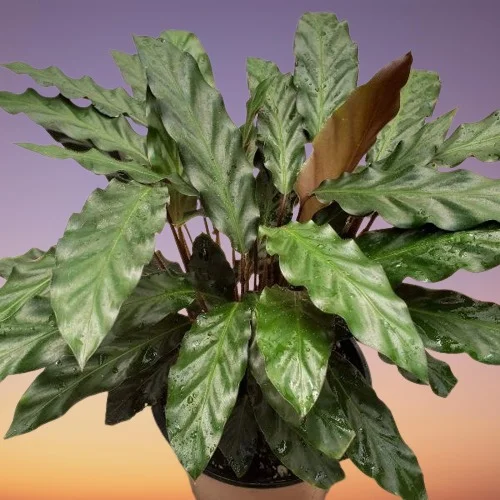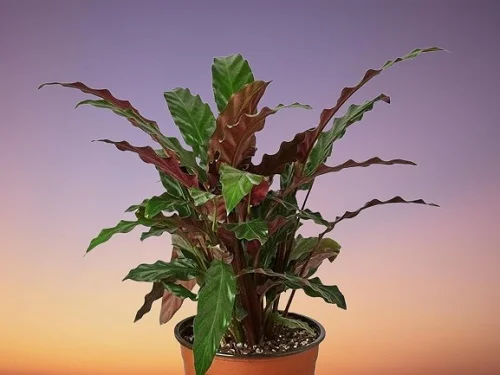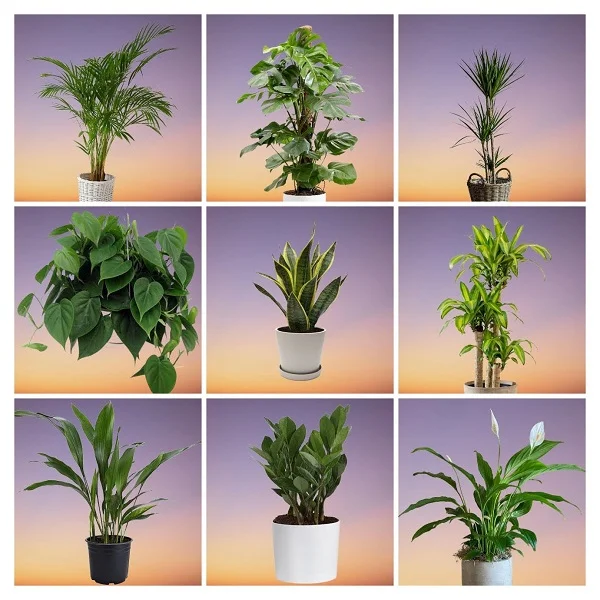Calathea rufibarba (Furry Feather Calathea) Indoor Care, Propagation and Common Problems
Some links in this post may be affiliate links
Furry Feather Calathea (Calathea rufibarba) grows best in bright indirect light, warm and humid conditions and moderately moist, fertile, well-drained soil coupled with monthly feeding in the growing season.
Calathea Rufibarba can thrive indoors and reward you with lush, tropical beauty. In this guide, you will learn everything about caring for Calathea Rufibarba indoors, including: ideal light, watering, humidity, propagation, and common problems. Let's first look at some facts about this eye-catching plant.
Calathea rufibarba also called Velvet Calathea is one of the popular Calathea varieties and bears red stems and deep blue-green, elongated leaves with a dark-purple underside.
The common names, 'Furry Feather Calathea' and 'Velvet Calathea', are in reference to the tiny hairs that cover the waxy leaves and stems which give the plant a soft, velvety feel to the touch.
On account of its fabulous foliage, Furry Feather Calathea is one of the best plants for the home and will create a delightful sight in any space.

Botanical name: Calathea rufibarba
Synonym: Goeppertia rufibarba
Family: Marantaceae
Common name: Furry Feather Calathea, Velvet Calathea
Origin
Calathea rufibarba also called Goeppertia rufibarba is native to the tropical rainforests of Bahia state of northeastern Brazil.
Is Calathea Rufibarba pet-friendly?
Calathea rufibarba like other Calathea Plants is non-toxic to both humans and pets as indicated by ASPCA. It is safe to for cats, dogs and other pets.
Related Plants
Furry Feather Calathea is related to the Marantas, Ctenanthe and Stromanthe which are collectively called Prayer Plants in reference to their curious characteristic of closing their leaves at night.
Where to Buy
Furry Feather Calathea are a perfect addition to any plant collection, you can get them online from Etsy (Link to Etsy) or from (Link to Amazon).
How do you care for Furry Feather Calathea indoors?
To care for Furry Feather Calathea give it bright indirect light, average warmth of 15-250C, humidity of 60-80% and moderately moist, rich, well-drained soil coupled with monthly feeding during the growing season.
Calathea rufibarba care requires repotting only when the plant becomes pot-bound. Pruning is necessary to keep it neat and also discourage pest and disease infestations. Keep reading for more on the growing conditions and how to achieve them.

Watering
How often do you water Calathea rufibarba?
Water your Calathea rufibarba liberally during the growing season while allowing the top 2-3 inches of soil to dry out between waterings.
Keep the soil moderately moist and never soggy. Avoid overwatering which can result in yellowing leaves and mushy stems.
Cut down on watering in the cold season (fall and winter) as growth is minimal at this time. Do not allow the soil to dry out completely to avoid crispy brown leaf edges and droopy foliage.
Use tepid water (water that is at room temperature) to avoid shocking this tropical plant as it can lead to reduced growth and droopy leaves.
Confirm that the water is free of chlorine and other dissolved chemicals; use rain water, filtered water or distilled water to avoid brown leaf tips and edges.
Ascertain that the pot has a drainage hole to prevent the soil from getting soggy as it can lead to root-rot which is characterized by yellowing, wilting and drooping leaves.
Avoid wetting the foliage during watering or water from the bottom instead to prevent fungal infestations like leaf spot diseases.
Pro tip: If using tap water, let it sit overnight before watering to allow chemicals to dissipate.
Light Requirements
How much light does a Calathea rufibarba need?
Calathea rufibarba thrives in medium to bright indirect light. Position the plant infront of a large brightly-lit window. Keep it away from direct sunlight as it cause loss of leaf color and scorching; brown spots on the leaves.
If the leaves start curling or becoming pale, move the plant to a brighter spot or instal grow lights where the natural lighting is not adequate.
Pro tip: For even growth and to prevent lopsided growth, regularly turn the pot to ensure that the plant receives light on all sides.
Temperature and Humidity
Furry Feather Calathea prefers average warmth of 15-250C. At temperatures below this range, the plant stops growing while temperatures above this range may cause the plant to die.
Keep it away from drafts originating from windy doors, drafty windows, AC units, heat sources and others as they cause flactuations in temperature which the plant cannot tolerate.
Calathea rufibarba requires humidity of 60% to 80% to thrive. Low humidity results in brown leaf tips and edges. To raise humidity, set the pot on a wet pebble tray, use a cool mist humidifier or group the plants together.
You may also grow the plant in a well-lit bathroom, kitchen, laundry area and other moist areas in the home. Velvet Calathea is one of the best plants for the bathroom on account of its requirement for warm, humid conditions.
Pro tip: Ensure that there is good air circulation for the plant to discourage fungal diseases.
Potting Medium
The best potting soil for Calathea rufibarba should be a light, well-draining, and nutrient-rich soil. A potting mix made up of 2 parts potting soil, 1 part perlite or sand, and 1 part coconut coir or peat moss is perfect for this plant.
Fertilizer
Feed your Calathea rufibarba with a balanced, liquid fertilizer every 3-4 weeks through out the growing season for a lush growth. Stop feeding in the cold season as growth is minimal and feeding at this time can lead to fertilizer burn.
Regularly, flush out accumulated chemicals (salts) from the soil by running a stream of water through the soil. Allow the stream of water to run for some time and repeat the process several times.
Repotting
Repot Calathea rufibarba every 2-3 years at the beginning of the growing season when it becomes root-bound to encourage a lush growth.
Use a pot one size larger than the current one. Make sure that the pot has a drainage hole to prevent the soil from getting soggy as it can lead to root-rot. Check out these planters with drainage hole on Amazon.
At least one day before repotting, water the plant thoroughly to hasten establishment as a well hydrated plant suffers less repotting shock.
Where the plant is large and has outgrown its current pot, divide it into several sections and use the splits to propagate new plants.
Once repotted the leaves may droop due to transplanting shock but the plant will eventually recover once it takes root (in about 3-4 weeks).
Pruning & Grooming
Pruning Calathea rufibarba is easy:
- Remove dead and yellow foliage to maintain the plant neat and reduce pest and disease infestations.
- Cut the leaves with a sharp knife or pruning scissors at the base, where the leaf meets the stalk.
Once in a while, clean the leaves by damp-wiping with a soft cloth to keep them clean and also discourage pest infestations.
Pro tip: Use a sterilized pruning scissors to avoid trasmitting diseases between plants.
Calathea rufibarba Propagation
Calathea rufibarba (Furry Feather Calathea) is best propagated by plant division at the beginning of the growing season (in spring). Dividing the plant at this time hastens establishment as it is in the active growth phase.
Learn more on how to propagate Calathea Plants in 2 easy ways.

Calathea rufibarba Problems and Remedies
Calathea rufibarba problems include drooping leaves, brown leaves, plant dying, brown leaf tips, curled and yellow leaves, loss of leaf color, pests and diseases among others. Keep reading for more on these problems and how to fix them.
Drooping leaves
Drooping leaves in Calathea rufibarba are due to dry air, overwatering, underwatering, soggy soil, and being pot-bound.
How to fix it
- Dry air: To increase humidity, set the pot on a wet pebble tray, use a humidifier or group the plants together to create a humid microclimate.
- Overwatering: Water when the top 1-2 inches of soil dry out. Do not water on a schedule.
- Underwatering: Water when the top soil feels dry. Do not allow the soil-ball to dry out completely.
- Soggy soil: Make sure that the soil is free-draining and that the pot has a drainage hole.
- Being pot-bound: Check the bottom of the pot for roots growing through the drainage hole and repot the plant. You may divide the plant into several sections and pot them in individual pots.
Check out these 10 causes of Calathea drooping leaves and how to revive it.
Brown leaves
Why are the leaves of my Calathea rufibarba turning brown?
Brown leaves on Calathea rufibarba are due to incorrect watering, soggy soil, temperature stress, direct sunlight, and overfertilizing.
How to fix it
- Incorrect watering: Water only when top few inches of soil feel dry to the touch. Never let the soil dry out completely.
- Soggy soil: Use well-drained soil and a pot that has a drainage hole.
- Temperature stress: Keep the plant away from drafts emanating from AC units, windy doors, stoves and others.
- Direct sunlight: Keep the plant away from direct sunlight or use a light curtain to filter the light.
- Overfertilizing: Feed monthy only in the growing season.
Read more on these 11 causes of brown leaves on houseplants with solutions.
Plant dying
Why is my Furry Feather Calathea dying?
Your Furry Feather Calathea is dying due to root-rot or pest infestations. Let's look at how to solve these issues.
How to revive a Furry Feather Calathea?
1. Root-rot: The disease is prevalent in poorly drained soil. It is characterized by yellowing and wilting of the leaves which is rapidly followed by browning and plant collapse.
- Slip the plant out of its pot and inspect the roots.
- Trim brown-black mushy roots and treat the healthy roots with a copper-based fungicidal solution as indicated by the manufacturer.
- Disinfect the pot with the fungicidal solution or use a fresh pot to repot the plant in fresh free-draining soil.
- Do not water the plant and keep it dry for some time before resuming watering
- To prevent root-rot in the future, ensure that the pot has a drainage hole to prevent the soil from getting soggy.
- Minimize watering in fall and winter as growth is minimal at this time; maintain the soil slightly moist.
2. Pest infestations: Calathea rufibarba is prone to mealybugs, aphids, scale insects, and spider mites infestations.
- Isolate the affected plant to prevent spread to the other houseplants.
- Treat it with an insecticidal soap or neem oil. Ensure to follow the manufacturer's instructions on the label.
- Regularly inspect the plant for these pests and carry out timely control measures.
- Keep the plant properly pruned to discourage these pests.
- Maintain a high humidity as these pests are more common in dry conditions.
Read more on these 12 reasons why Calathea is dying and how to save it.
Brown, dry leaf tips and edges
Brown, dry leaf tips and edges on Calathea rufibarba are due to dry air, spider mites infestation, hard water, and salts build-up.
How to fix it
- Low humidity: To elevate humidity, set the pot on a wet pebble tray or grow the plant in a well-lit bathroom and other moist areas in the home.
- Spider mites infestation: Remove the dead growth, treat the plant with an insecticidal soap, raise humidity and keep the plant well pruned.
- Hard water: Use rain water, distilled water or filtered water.
- Salts build-up: Flush out accumulated salts from the soil every 1-2 months by running a stream of water through the soil.
Curled and yellowing leaves
Curled and yellowing leaves on Calathea rufibarba overwatering and underwatering. Water only when the top 1-2 inches of soil dry out and never allow the soil to dry out completely. Use well-drained soil and a pot with a drainage hole.
Loss of leaf color
Loss of leaf color in Calathea rufibarba is due to exposure to hot direct sunlight. Place the plant in a more shaded spot or instal a light curtain to shield it from direct sunlight to prevent its eventual death.
Diseases
Calathea rufibarba is prone to leaf spot disease which is enhanced by warm, humid conditions. The disease is characterized by brown patches surrounded by a yellow halo.
Isolate the affected plant to prevent spread to the other plants and treat it a systemic fungicide. Ensure to follow the manufacturer's directions on the label.
Conclusion
Calathea Rufibarba (Furry Feather Calathea) is a gorgeous, tropical plant that adds soft, velvety texture to any indoor space. With the right care: humidity, indirect light, and consistent watering, it will thrive and reward you with stunning foliage for years.
You liked it? Share on social media.
Related Content
Amazon Associates Disclosure
Homeplantsguide.com is a participant in the Amazon Services LLC Associates Program, an affiliate advertising program designed to provide a means for sites to earn advertising fees by advertising and linking to amazon.com.





